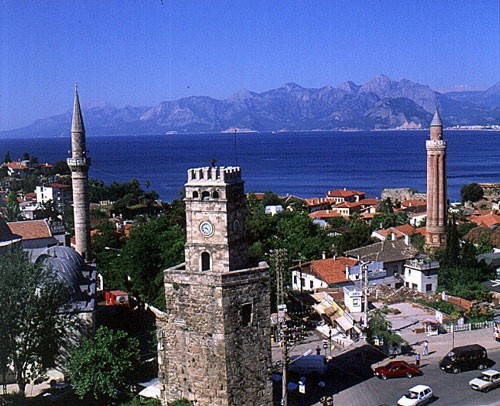The city served as a naval base for Attalus’s powerful fleet. Excavations in 2008, in the Doğu Garajı plot, uncovered remains dating to the 3rd century BC, suggesting that Attalea was a rebuilding and expansion of an earlier town.
Attalea became part of the Roman Empire in 133 BC when Attalus III, a nephew of Attalus II, bequeathed his kingdom to Rome at his death in 133 BC. The city grew and prospered during the Ancient Roman period and was part of the Roman province of Pamphylia Secunda, whose capital was Perga.
Christianity started to spread to the region even in the 1st century: Attalea was visited by Paul of Tarsus and Barnabas, as recorded in the Acts of the Apostles: “Then they passed through Pisidia and came to Pamphylia. And when they had spoken the word in Perga, they went down to Attalea, and from there they sailed to Antioch”.
Some of the bishops attributed to the episcopal see of Attalea in Pamphylia may instead have been bishops of Attalea in Lydia (Yanantepe), since Le Quien lists them under both sees. No longer a residential bishopric, Attalea in Pamphylia is today listed by the Catholic Church as a titular see.
The 13th-century Seljuk mosque at Attalea, now in ruins, had been a Christian Byzantine basilica from the 7th century. The Great Mosque had also been a Christian basilica and the Kesik Minare Mosque had been the 5th-century Christian Church of the Panaghia or Virgin and was decorated with finely carved marble.
The archaeological museum at Attalea houses some sarcophagi and mosaics from nearby Perga and a casket of bones reputed to be those of St. Nicholas, the bishop of Myra, further down the Turquoise coast. The area of Antalya was subject to naval attacks by the Arabs of the Abbasid Caliphate.
Attalea was a major city in the Byzantine Empire. It was the capital of the Byzantine Theme of the Cibyrrhaeots, which occupied the southern coasts of Anatolia. According to the research of Speros Vryonis, it was the major naval station on the southern Anatolian coast, a major commercial center, and the most convenient harbor between the Aegean Sea and Cyprus and points further east. Besides the local merchants, “one could expect to see Armenians, Saracens, Jews, and Italians.”
At the time of the accession of John II Comnenus in 1118, Attalea was an isolated outpost surrounded by Turkish beyliks, accessible only by sea.
Following the fall of Constantinople in 1204, Niketas Choniates records that one Aldebrandus, “an Italian by birth who was strictly raised according to Roman tradition” controlled Attalea as his own fief.
When Kaykhusraw, sultan of the Seljuk Turks attempted to capture the city in 1206, Aldebrandus sent to Cyprus for help and received 200 Latin infantry who defeated the attackers after a siege of less than 16 days.
Kaykhusraw would take Attalea the following year and build its first mosque. Christians rebelled and captured Attalea with aid of Walter of Montbéliard in 1212. Briefly restored Byzantine rule in Attalea was ended by Kaykaus I in 1216.


































